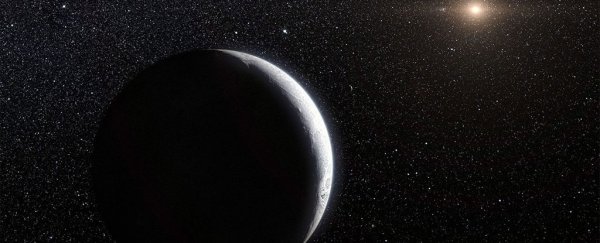Scientists have announced the discovery of a new icy world on the fringes of the Solar System, and while this distant object is only very small, it could help us track down something that's meant to be much, much bigger: the hypothesised but as yet unconfirmed Planet Nine.
The new discovery – called L91 – is what's known as a Trans-Neptunian Object (TNO), meaning it's a small world that orbits the Sun beyond Neptune. And that extreme distance means it takes L91 an awfully long time to make its way around the Solar System.
Neptune is the most remote confirmed planet in our Solar System, orbiting the Sun at a distance of about 4.5 billion kilometres (2.8 billion miles). In scientific terms, that's around 30 astronomical units (AUs) – meaning 30 times the distance between Earth and the Sun.
But L91 casts an even wider arc. The closest it gets to the Sun is 50 AUs, but its elliptical orbit sees it eventually trek as far away as 1,430 AUs from the Sun, before inching back inwards again.
"It's right at the limit of what we can detect," astrophysicist Michele Bannister from Queen's University Belfast in the UK told Adam Mann at Science.
That awesome loop means it takes L91 more than 20,000 years to orbit the Sun, and gives the icy world the status of the second greatest maximum orbital distance from the Sun (or aphelion) for a known TNO.
That means L91 beats the minor planet Sedna (at 939 AUs) but not the recently discovered asteroid 2014 FE72 (4,274 AUs).
But perhaps even more remarkable is the fact that L91's orbital trajectory appears to be in transition, with the tiny world migrating from one body of objects called the Oort cloud to another group nearby, the Kuiper belt.
This kind of transition has never been observed before in a TNO, and the team that found L91 thinks it could be due to the historical effects of Neptune's pull on the minor planet – perhaps paired with gravitational interactions with a passing star.
But not everybody is convinced with this explanation.
"It's a story that's not implausible, but I also think it's not needed," planetary scientist Konstantin Batygin from the California Institute of Technology (Caltech), who wasn't involved with the discovery, told Science.
Batygin was part of the team that originally posed the Planet Nine hypothesis, and he thinks that this massive, still unseen world – also thought to lurk on the outskirts of the Solar System – could be what's responsible for unusual orbits of lots of smaller objects like L91.
In their study, which has not yet been published, Bannister's team looked at whether a Planet Nine-style mass – estimated to be about 10 times the mass of Earth – could explain L91's movements, but the initial calculations suggested not.
But with scientists finding more and more of these distant objects on the periphery of the Solar System, our ability to analyse their movements becomes stronger – meaning the hunt for Planet Nine gets a little bit closer every day.
"Every time we find another one of these objects, it adds another piece to the puzzle," one of the team, Meg Schwamb from the Gemini Observatory in Hilo, Hawaii, told Alexandra Witze at Nature.
The findings were presented at a meeting of the American Astronomical Society's Division for Planetary Science in Pasadena, California this week.
